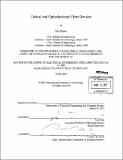Optical and optoelectronic fiber devices
Author(s)
Shapira, Ofer, Ph. D. Massachusetts Institute of Technology
DownloadFull printable version (36.53Mb)
Other Contributors
Massachusetts Institute of Technology. Dept. of Electrical Engineering and Computer Science.
Advisor
Yoel Fink.
Terms of use
Metadata
Show full item recordAbstract
The ability to integrate materials with disparate electrical, thermal, and optical properties into a single fiber structure enabled the realization of fiber devices with diverse and complex functionalities. Amongst those, demonstrated first in our work, are the surface-emitting fiber laser, the hollow-core fiber amplifier, the thermally self-monitored high-power transmission fiber device, and the photo-detecting fiber-web based imaging system. This work presents the design, analysis, and characterization of those devices. It opens with a study of the transmission properties of the multimode hollow-core, photonic bandgap fiber constructed of a periodic multilayer cladding. A defect is then introduced into one of the cladding layers and the interaction between core and defect modes is investigated. The second chapter addresses the experimental problem encountered in many multimode waveguide applications: how to extract, and to some extent to control, the modal content of the field at the output of a waveguide. We developed a non-interferometric approach to achieve mode decomposition based on a modified phase retrieval algorithm that can yield the complete vectorial eigenmode content of any general waveguiding structure and demonstrated its validity experimentally. In the third chapter an active material is introduced into the hollow-core to form a surface-emitting fiber laser. A unique azimuthally anisotropic optical wave front results from the interplay between the cylindrical resonator, the anisotropic gain medium, and the linearly polarized axial pump. We show that the direction and polarization of the wave front are directly controlled by the pump polarization. (cont.) In the last two chapters, a new type of fiber is presented, constructed of semiconducting, insulating, and conducting materials, which enables the integration of semiconductor devices into the fiber structure. In the first we demonstrate a fiber comprised of an optical transmission element designed for the transport of high power radiation and multiple thermal-detecting elements encompassing the hollow core for distributed temperature monitoring and real-time failure detection. In the second, we demonstrate optical imaging using large-area, three-dimensional optical-detector arrays, built from one-dimensional photodetecting optoelectronic fibers. Lensless imaging of an object is achieved using a phase retrieval algorithm.
Description
Thesis (Ph. D.)--Massachusetts Institute of Technology, Dept. of Electrical Engineering and Computer Science, 2007. Includes bibliographical references (p. 111-119).
Date issued
2007Department
Massachusetts Institute of Technology. Department of Electrical Engineering and Computer SciencePublisher
Massachusetts Institute of Technology
Keywords
Electrical Engineering and Computer Science.